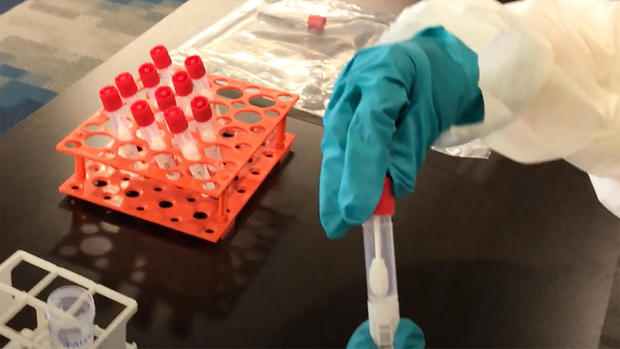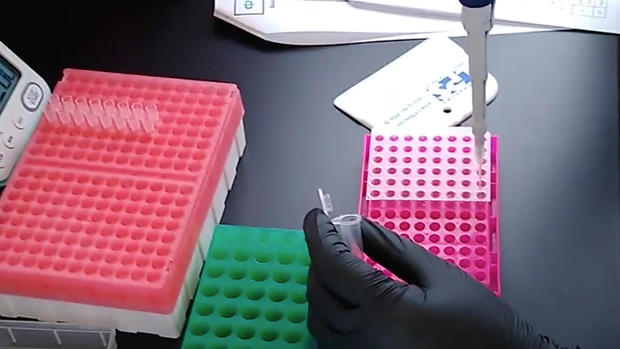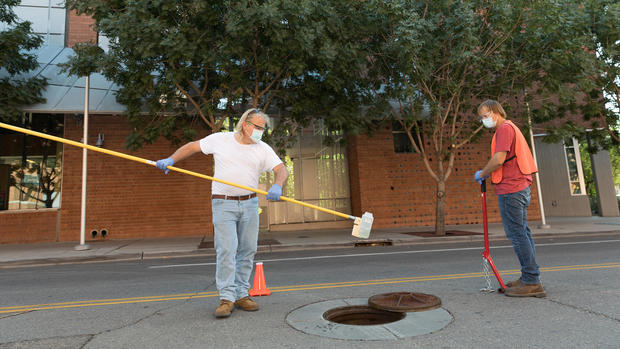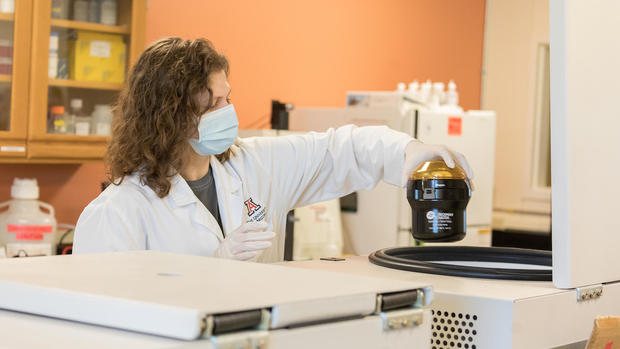Universities search for a blueprint to continue in-person instruction as COVID-19 pandemic rages
From New York to Arizona, university administrators are mining sewage as part of their COVID-19 containment strategies.
In Central New York, Syracuse University has begun monitoring dormitory wastewater for the presence of the COVID-19 virus. The university hopes this newly implemented tactic will help detect the virus early and supplement its diagnostic testing and contact-tracing infrastructure to break chains of transmission before an outbreak becomes unmanageably widespread.
"The whole thing about infectious disease control is that you have to find the virus to stop the virus," Dr. David Larsen, an epidemiologist and expert in global health at Syracuse University, told 60 Minutes Overtime. "We need to point our testing to where we suspect there are going to be cases."
Larsen, a professor at Syracuse's David B. Falk College of Sport and Human Dynamics, believes wastewater can be that guide. He began advising university administrators in late February on how to proceed as the coronavirus threat increased.
The week of March 9, the school began transitioning its nearly 23,000 students to remote learning for the remainder of the spring semester. By May, Larsen had shifted his focus to aiding the university in formulating a plan to resume on-campus classes for the fall semester. Larsen and Syracuse were not alone.
In June, 60 Minutes correspondent John Dickerson reported from the University of North Carolina and William & Mary on the challenges faced by colleges and universities as they prepared for the fall semester.
"The council of presidents is thinking…about what's the testing protocol that we want to use and will be aligning with the Department of Health and CDC guidelines," Katherine Rowe, the president of William & Mary, told John Dickerson in June.
Rowe told 60 Minutes in June that her school planned to conduct pre-arrival COVID-19 testing for anyone returning to campus for the fall semester. William & Mary said it plans to continue prevalence testing throughout the semester. The university strategy includes testing students and employees in higher-risk jobs more often.
In Chapel Hill last spring, the University of North Carolina was also deciding how it would allocate testing resources.
"There's still some debate about the value and the efficacy of baseline testing because you could baseline test a student the day that they arrive and that could change over the course of three or four days," Kevin Guskiewicz, chancellor of the University of North Carolina at Chapel Hill, said to 60 Minutes in June.
UNC decided not to test students for COVID-19 before arriving on campus.
"We'll look for clusters," Guskiewicz told John Dickerson in June "If there was a cluster of positive cases that would potentially create an off-ramp for us and we could pivot back to a remote learning environment."
Guskiewicz's statement proved prescient. UNC Chapel Hill said a total of 189 of the 1,002 students who live in its Granville Towers residence complex tested positive for COVID-19. On August 19, UNC shifted all undergraduate instruction back to remote learning.
"We regret that this transition caused a great deal of frustration for so many of our students and their families who had to change their fall living arrangements," Guskiewicz told 60 Minutes Overtime. "We also regret that the thousands of students who were strictly abiding by the University's Community Standards were unable to complete the term in their residence halls and classrooms as they had planned."
A UNC spokesperson said the school's size led its infectious disease experts to be wary that pre-arrival testing and voluntary quarantining would be sufficient to eliminate every asymptomatic coronavirus carrier. The school also said its experts considered the COVID-19 tests available at the time and expressed concern about "false reassurance from one negative test at a single point in time."
In guidance issued on June 30, the Centers for Disease Control and Prevention said it "does not recommend entry testing of all returning students, faculty, and staff." The CDC states that entry testing "has not been systematically studied" and that it is unknown if entry testing "provides any additional reduction in person-to-person transmission of the virus beyond what would be expected with implementation of other infection preventive measures."
"In reviewing the experiences to date, it seems possible that pre-screening might have delayed spread of infection through identification of some asymptomatic but infected students but would have been unlikely to eliminate it," a UNC spokesperson claimed to 60 Minutes Overtime.
Five-hundred miles north, Syracuse University was still five days away from the start of fall classes. Students were trickling onto campus, but an ominous start of the semester for fellow Atlantic Coast Conference member UNC demonstrated how quickly the virus could spread on campus.
Syracuse established a multi-part testing strategy to try to lessen the likelihood its student body would contribute to a communitywide spike in coronavirus cases.
The university required all students to take a COVID-19 test prior to arriving on campus. Those traveling from states or territories with high levels of communitywide virus transmission were asked to quarantine for 14 days, as required by New York Governor Andrew Cuomo's June 24 Executive Order.
Students participated in a second round of nasal swab or pooled saliva testing upon arriving on campus.
The pooled salvia testing process involves collecting oral swabs from each person. The swab is placed in a stabilizing solution. An aliquot from an individual sample is combined with up to 25 other samples and tested as a batch in an effort to speed up the process. If the batch tests positive for COVID-19, a second aliquot is taken from the individual samples and tested separately to identify the individual who has the virus.
A third round of testing at Syracuse begins on September 8.
As of September 2, Syracuse said it has administered 23,256 COVID-19 tests at the university. It reports 9 active cases on its campus.
The university's effort to test wastewater is aimed at maximizing the efficiency of its PCR testing resources going forward.
"From the beginning, I was very interested in leveraging wastewater to show the absence of [COVID-19] transmission, [and] to show that a community in rural New York is free of coronavirus," Syracuse professor David Larsen told 60 Minutes Overtime. "It doesn't mean that their risk is gone; because you could always have importation, but why not open up the school, why not open up the playground, why not visit grandma in that community? Let's get our lives back to normal a bit and the only way I know how to do that safely is with the data. And this is an unbiased estimate of transmission."
Syracuse's wastewater project began in March when Larsen saw a tweet from the Netherlands about a group testing sewage to determine the prevalence of COVID-19. By the end of the month, Larsen secured seed funding from the university and built a team that installed Syracuse's first wastewater sampling pump on campus. It plans to add at least 20 additional sampling pumps on across the university.
Larsen explained that each pump takes a 24-hour composite sample where a small amount of water is collected every 15 minutes. The composited samples are sent to a lab at Quadrant Biosciences twice a week. Each sample is run through an ultracentrifuge and then tested for viral RNA using a PCR test. Larsen said the results are returned in less than two days.
If the wastewater yields traces of viral RNA, a spokesperson from Syracuse University said the school plans to notify the building's residents accordingly and perform further testing. Larsen notes that someone who recovered from COVID-19 can continue to shed viral RNA in feces for weeks after recovery.
Sampling wastewater for COVID-19 is already working, according to administrators at the University of Arizona. A spokesperson for the university said the school tests the wastewater of 20 dormitories twice a week. It receives results back from an on-campus lab the same day.
Wastewater samples from three dormitories at The University of Arizona have tested positive for COVID-19, according to a school spokesperson.
As reported by The Washington Post, a wastewater sample from Arizona's Likins Hall was the first to come back positive. The school said all 311 residents living in Likins Hall were administered COVID-19 nasal swab antigen tests the next day. The university told 60 Minutes Overtime three asymptomatic students tested positive for coronavirus and were placed in isolation. A university spokesperson said the school is using contract tracers to determine if the virus spread beyond the three individuals.
The school said it is in the process of testing the residents at the other two dormitories to determine if any students actively have for the virus. It declined to name the facilities citing Family Educational Rights and Privacy Act laws.
Arizona said it required every student moving into university-provided housing to take a rapid antigen test on move-in day. As of September 2, a spokesperson said more than 4,000 students were tested as part of the move-in screening process with three students testing positive for coronavirus.
The university said it cannot legally require students living off-campus to follow the same testing requirements as the students that live in university-provided housing. An Arizona spokesperson said the school is partnering with the City of Tucson and Pima County to ensure testing is available for off-campus students.
As of September 1, the University of Arizona said it has conducted 12,509 COVID-19 antigen tests, 166 of which came back positive. The school's testing strategy also uses PCR testing. The school said of the 502 PCR tests administered as of September 1, two were positive.
The next challenge for the University of Arizona comes as it begins to scale its population. A university spokesperson said about 16,000 students, faculty, and staff are currently on campus. The school expects that number to jump to 28,000 within the next two weeks. It hopes wastewater will continue to detect outbreaks before they become widespread.
Sampling sewage to detect the presence of a virus dates back to at least the 1930s when a team at Yale University published its findings on the prevalence of polio in waste taken from Charleston, South Carolina.
While technology associated with waste monitoring has drastically improved since its early use, Syracuse's David Larsen said the system is still not perfect.
"It won't catch every infection, but it will give us an advantage," Larsen said. "Not every individual will shed RNA in their feces. About half that are infected with coronavirus do. If we [have] early detection of a coronavirus case and we find that case and we break that chain of transmission…that still puts us at a 50% more advantage than before."
The 50% advantage Larsen speaks of could prove vital for the New York-based institution to stay open with in-person instruction. On August 27, Gov. Cuomo issued guidance that says schools with coronavirus cases that equal 5% of its population or 100 total cases must pivot to remote learning for two weeks.
Back in Chapel Hill, the University of North Carolina is reassessing its plan for in-person instruction for the spring semester.
"Currently we are focused on supporting our campus community, the success of our students and our mission of teaching, education and research through this semester," UNC chancellor Kevin Guskiewicz told 60 Minutes Overtime. "In addition, we are in the process of pivoting our Roadmap Implementation Team to evaluate the full scope of planning, implementation and results from the fall term, and working with state and local public health officials, faculty public health experts, the University System and input from a to-be-convened advisory group."
Guskiewicz said the advisory group will include students, faculty, and staff.
In Virginia, William & Mary said it is in the process of phasing students back onto campus. The first group to populate the Virginia institution were new students, graduate students, and international students. Sophomores, juniors, and seniors return this weekend.
The university reported at least 29 positive cases of coronavirus from its pre-arrival screening of faculty and staff. As of September 3, the school said it has conducted more than 7,000 student tests. It is yet to report a positive student case on campus.









